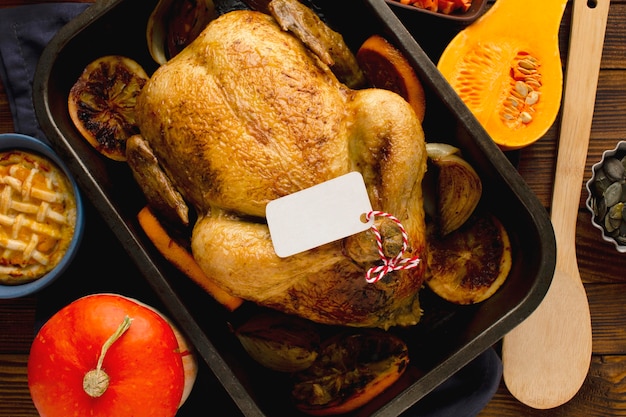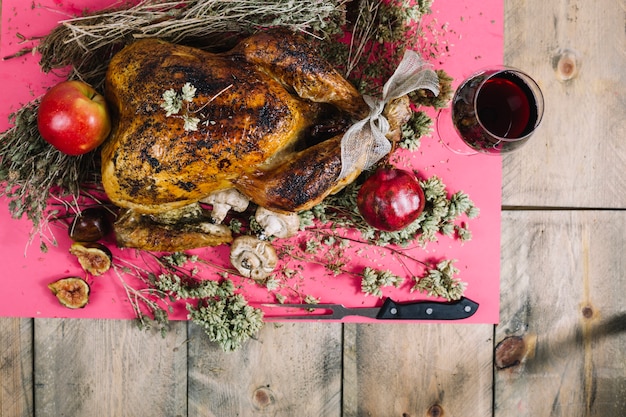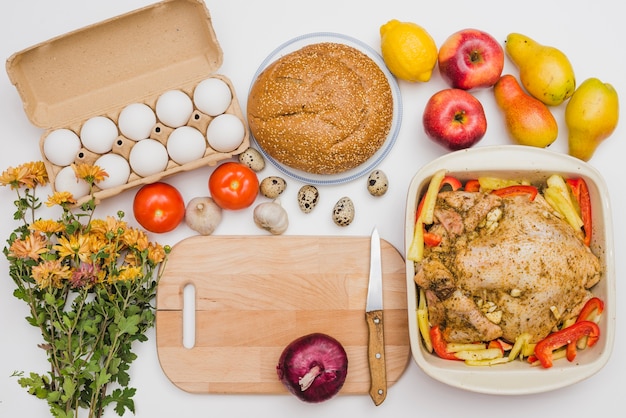The aroma of a perfectly roasted chicken, its skin a glistening, golden brown, and the succulent meat yielding to the slightest touch - it's a sensory delight that sets the stage for a truly satisfying meal. It's a dish that’s been gracing tables for generations, and for good reason. But let’s face it, achieving that picture-perfect roast chicken isn't always a walk in the park. Over the years, I've tackled countless chickens, from the humble supermarket bird to the luxurious free-range variety. Through trial and error, I've honed my techniques and discovered the little secrets that make all the difference. So, settle in, grab your favourite beverage, and let's embark on a culinary journey together, where we'll uncover the art of roasting a chicken to perfection.
(Part 1) The Foundation: Choosing the Right Bird

The journey begins with selecting the right canvas for our masterpiece - the chicken itself. While a supermarket chicken can be delicious when cooked well, I often opt for a free-range chicken whenever possible. The difference in flavour and tenderness is undeniable. But no matter where it comes from, here are some crucial factors to keep in mind:
Size Matters: The Goldilocks Principle
When it comes to roast chicken, size is a significant factor. I generally aim for a chicken weighing between 1.5kg and 2kg. It's a perfect size for a family of four and allows for even cooking. For a larger gathering, you'll need to scale up accordingly. Remember, a larger bird will require more cooking time, so factor that into your schedule.
The Visual Inspection: A Chicken's Tell-Tale Signs
Once you've found a chicken that fits the bill, give it a thorough inspection. The skin should be intact, without any tears or holes. The flesh should be firm and not overly dry. If you can, take a sniff. A fresh chicken should have a clean, mild odour. If you detect any unpleasant smells, it's best to avoid that chicken.
(Part 2) Prepping for Perfection: Setting the Stage

Before we even think about the oven, there are a few crucial prep steps that elevate a roast chicken from ordinary to extraordinary.
The Great Debate: To Wash or Not to Wash?
While many cooks insist on washing their chicken before roasting, I'm firmly in the camp that says it's unnecessary. In fact, washing can actually increase the risk of spreading bacteria around your kitchen. Instead, I opt for a thorough pat down with paper towels to remove any excess moisture, which helps to achieve a crispy skin.
Seasoning with Savvy: A Symphony of Flavours
Now comes the fun part - seasoning! I believe in simplicity, opting for a good sprinkle of salt and pepper. But feel free to unleash your culinary creativity with other spices like garlic powder, paprika, or a sprinkle of herbs like rosemary or thyme. I like to rub the seasoning under the skin as well as on the outside, allowing the flavours to penetrate the chicken for maximum impact. Don't shy away from using a generous amount of salt, as it helps draw out the moisture and enhance the chicken's natural flavour.
Stuffing: To Stuff or Not to Stuff?
Stuffing a chicken can add a delicious dimension to the meal, but it can also make even cooking more challenging. If you're going the stuffing route, make sure it's cooked separately and free of raw ingredients. My personal preference is a simple stuffing of herbs and garlic, but the possibilities are endless. For a simpler roast, skip the stuffing altogether and focus on maximizing the chicken's natural flavours.
(Part 3) roasting time: Bringing the Chicken to Life

Finally, the moment of truth - it's time to unleash the power of the oven. This is where the chicken truly transforms into a culinary masterpiece.
The Temperature Tango: Finding the Sweet Spot
I always roast my chicken at 180°C (350°F) fan assisted. This temperature ensures a beautiful golden-brown crust while maintaining a moist and tender interior.
Timing is Everything: The Chicken's Clock
The cooking time will vary depending on the size of your bird. As a general guideline, allow about 45 minutes to an hour per kilogram. So, for a 1.5kg chicken, you'd be looking at roughly 1 hour and 15 minutes of cooking time. However, the true judge of doneness is a trusty meat thermometer. The chicken should reach an internal temperature of 74°C (165°F) in the thickest part of the thigh.
Basting: The Secret to Juicy Perfection
As the chicken roasts, it's a good practice to baste it every 20 minutes or so with the pan juices. This keeps the chicken moist and helps create that irresistible golden-brown crust.
Resting: The Key to Tenderness
Once the chicken is cooked through, resist the urge to carve it immediately. Let it rest for 10-15 minutes before slicing. This allows the juices to redistribute throughout the meat, ensuring it's incredibly tender and juicy. While the chicken rests, consider making a delicious pan sauce with the pan drippings. Simply add butter, flour, herbs, and a touch of stock to the pan, and whisk it all together until you have a delectable sauce to accompany your masterpiece.
(Part 4) The Art of Roasting: Techniques and Tricks for Success
Now, you might be thinking, "I've got the basics down, but how do I achieve that perfect roast chicken that everyone raves about?" It’s a question that many aspiring chefs ask. And the answer lies in mastering a few subtle techniques and tricks.
Space is Key: Giving the Chicken Room to Breathe
Ensure you have enough space in your oven for the chicken to cook evenly. For larger birds, using a roasting rack to elevate the chicken above the bottom of the oven is highly recommended. This allows the hot air to circulate freely around the bird for a more consistent cook.
Positioning Power: Placing the Chicken Strategically
Now, let's talk about placement. I prefer to position the chicken with the breast side facing the front of the oven. This helps ensure the breast cooks evenly, as it tends to dry out more quickly than other parts of the chicken. If using a roasting rack, place it in the middle of the oven, away from the heating elements.
Fat Management: Keeping the Drippings in Check
As the chicken roasts, it will release fat. Keep a watchful eye on the fat and spoon it out if it starts to accumulate in the bottom of the pan. Excess fat can hinder browning and even cause the chicken to steam rather than roast.
The Right Tools for the Job: Choosing the Perfect Pan
The roasting pan you choose can play a significant role in achieving the desired result. I'm partial to cast-iron pans because they heat up evenly and contribute to a beautifully crispy skin. If you're using a different type of pan, make sure it's oven-proof and has a lid, as this can be helpful for certain cooking methods.
(Part 5) Completing the Masterpiece: side dishes that Elevate the Experience
Your perfectly roasted chicken is a culinary triumph, but no masterpiece stands alone. Choosing the right side dishes can elevate the entire experience, creating a symphony of flavours that will leave your guests wanting more.
roast vegetables: A Classic Pairing
Roasted vegetables are a classic companion for roast chicken, offering a delicious and satisfying contrast of textures and flavours. I love to roast potatoes, carrots, onions, and garlic alongside the chicken. Toss them with olive oil, salt, and pepper, and allow them to roast in the oven's warmth, absorbing the chicken's delicious aroma and juices.
Gravy: The Finishing Touch
No roast chicken is complete without a rich and flavorful gravy. As I mentioned earlier, I prefer to make a pan sauce using the chicken drippings, which creates a far more delicious and nuanced gravy than instant granules.
Salads: A Touch of Freshness
To add a touch of freshness and lightness to the meal, I always serve a salad alongside my roast chicken. A simple green salad with a vinaigrette dressing is perfect, but you can also explore more substantial options like a potato salad or a creamy coleslaw.
(Part 6) Beyond the Basics: Variations that Ignite culinary adventure
While a classic roast chicken is a timeless favourite, don't be afraid to get creative and experiment with different flavour profiles. Here are a few variations on the theme to inspire your culinary exploration.
Herbed Chicken: A Symphony of Aromas
Rub the chicken with a mixture of fresh herbs like rosemary, thyme, and sage for a fragrant and aromatic experience. You can also stuff the chicken cavity with herbs and garlic for a deeper flavour infusion.
Citrus Chicken: A Burst of Tangy Delight
For a tangy and refreshing twist, roast the chicken with citrus fruits like lemons or oranges. Stuff the chicken with citrus slices or simply rub the skin with citrus zest for a vibrant flavour boost.
Spiced Chicken: A Journey into Global Flavors
If you enjoy a touch of heat, experiment with roasting the chicken with chili flakes, paprika, or cumin. You can also explore pre-made spice blends like jerk seasoning or curry powder for a more exotic flavour profile.
(Part 7) Navigating the Culinary Journey: Troubleshooting and Tips for Success
Even the most seasoned cooks can encounter a few bumps in the road. Here are some common challenges you might face when roasting chicken and their solutions:
Dry Chicken: Avoiding a Culinary Disaster
If your chicken turns out dry, it's likely because it was overcooked. To prevent this, always cook your chicken to the correct internal temperature and allow it to rest for 10-15 minutes before carving. You can also consider basting the chicken with pan juices or butter during cooking to help retain moisture.
undercooked chicken: Ensuring food safety
On the other hand, if your chicken is undercooked, it's crucial to cook it for longer. Always use a meat thermometer to check the internal temperature, as it's the only way to ensure food safety. It should reach 74°C (165°F) in the thickest part of the thigh.
Burnt Chicken: Preventing a Charcoal Surprise
If the skin of your chicken is burnt, it's likely because the oven temperature was too high. Try reducing the oven temperature slightly and/or using a lower shelf position in your oven to prevent scorching.
Uneven Cooking: Achieving Consistency
If your chicken is cooking unevenly, it's likely because it's not positioned correctly in the oven. Make sure the chicken is positioned in the middle of the oven, away from the heating elements. Using a roasting rack can also help promote even cooking by allowing hot air to circulate freely around the chicken.
(Part 8) FAQs: Addressing Common Questions
I understand that you might have some questions as you embark on your roast chicken journey. Here are some answers to frequently asked questions:
Q: How do I know when my chicken is cooked?
The most reliable way to determine if your chicken is cooked is by using a meat thermometer. The internal temperature should reach 74°C (165°F) in the thickest part of the thigh. You can also check by piercing the thickest part of the thigh with a sharp knife. The juices should run clear, not pink.
Q: What should I do with the leftover chicken?
leftover roast chicken is a culinary treasure! It's perfect for salads, sandwiches, or hearty soups. You can also shred it and use it in pasta dishes or casseroles.
Q: Can I freeze roast chicken?
Yes, you can freeze roast chicken. Let it cool completely, wrap it tightly in cling film or foil, and then place it in a freezer-safe bag. It will keep in the freezer for up to 3 months.
Q: How do I make the skin crispy?
The key to crispy chicken skin is to dry it thoroughly before roasting. Pat the chicken dry with kitchen paper and ensure it's not sitting in any water. You can also rub the skin with a little salt or oil before roasting to promote browning.
Q: What is the best way to store leftover chicken?
Once the chicken has cooled completely, store it in an airtight container in the refrigerator for up to 3 days. You can also freeze leftover chicken for up to 3 months.
(Part 9) My Personal Roast Chicken Journey: A Culinary Reflection
So, there you have it - my comprehensive guide to roasting a whole chicken to perfection. It's a journey I've been on for years, filled with triumphs and, admittedly, a few mishaps along the way. I remember the first time I roasted a chicken, I was so nervous! I followed a recipe religiously, but the chicken came out dry, and the skin was pale. It was a culinary disaster! But I was determined to master this classic dish. I kept practicing, experimenting with different recipes and techniques, and gradually discovered what worked best for me.
Now, roast chicken is one of my favourite things to cook. It's a dish that evokes happy memories of family meals and cosy nights in. I love the satisfaction of creating something delicious and comforting from scratch. And I love seeing the smiles on everyone's faces when they take their first bite.
So, don't be intimidated by the prospect of roasting a whole chicken. Trust me, it's easier than you think. Remember, there's no one right way to roast a chicken. Experiment, have fun, and don't be afraid to make mistakes. That's how we learn and grow as cooks!
Happy roasting!
Everyone is watching

Corn on the Cob: The Ultimate Guide to Perfectly Cooked Ears
Healthy MealsAh, corn on the cob. Just the name evokes images of sunny days, barbecues, and that sweet, juicy flavour that ...

Perfect Pork Roast Oven Cooking Time: A Guide to Delicious Results
Healthy MealsThere's something truly satisfying about a perfectly roasted pork. The aroma alone is enough to make your mout...

Ham Cooking Time: How Long to Bake, Smoke, or Boil a Delicious Ham
Healthy MealsAh, ham. It's a classic, isn't it? A real crowd-pleaser, especially around holidays. And when done right, it'...

Scallops: The Ultimate Guide to Perfect Cooking
Healthy MealsAh, scallops. Those delicate, sweet, and utterly delicious morsels of the sea. They hold a special place in my...

Spaghetti Squash: The Ultimate Guide to Cooking and Serving
Healthy MealsRemember that time you saw spaghetti squash at the supermarket, looking all bumpy and strange, and thought, "W...
